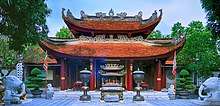Lý Bát Đế Shrine
The Lý Bát Đế Temple or Đô Temple (Vietnamese: Đền Lý Bát Đế or Đền Đô), formal Buddhist name Cổ Pháp Điện, is a temple near Hanoi of which the central section was built in 1028 on the death of Lý Thái Tổ (李太祖), and the complex enlarged as seven of his descendant Lý Dynasty emperors were also buried at the shrine – Lý Bát Đế means "Eight Lý Emperors." Traditionally the shrine serves for ancestor worship of the eight emperors. It is located in Đình Bảng Commune, Từ Sơn District, in the Red River Delta province of Bắc Ninh.[1][2] Another national monument, Đình Bảng communal house, is adjacent.[3]


Main hall and side halls
The main hall of the shrine is used for the worship of the Lý emperors. The Văn chỉ hall at the right of the main hall is used for the worship of Lý Đạo Thành and Tô Hiến Thành, two high-ranking civil mandarin officers who served the Lý Dynasty. The Võ Chỉ Hall at the left of main hall is dedicated to the worship of generals Lý Thường Kiệt, Lê Phụng Hiểu and Đào Cam Mộc.
Water Pavilion and lake
Entry into the complex is by the Five Dragon Gate (Ngũ long môn). Immediately after the gate is the Half Moon Lake (hồ bán nguyệt), so called because of its half-moon shape. At the front of the half-moon shaped lake stands a pavilion called Thủy Đình built into the lake which today hosts water puppet plays and quan họ singing.
Restoration in the 1990s as a national monument
Đình Bảng, Từ Sơn native and president of the Vietnam Fatherland Front Lê Quang Đạo was one of the government figures instrumental in the restoration of the Đô Temple as a national memorial. Party leaders bow before the altar as acts of national remembrance of the patriotism of the Lý kings, rather than as religious worship.[4]
Reigns of the eight emperors:
- Lý Công Uẩn namely Lý Thái Tổ (1009–1028)
- Lý Thái Tông (1028–1054)
- Lý Thánh Tông (1054–1072)
- Lý Nhân Tông (1072–1128)
- Lý Thần Tông (1128–1138)
- Lý Anh Tông (1138–1175)
- Lý Cao Tông (1175–1210)
- Lý Huệ Tông (1210–1224)
Gallery
- Altar for Lý Công Uẩn (Lý Thái Tổ), the founder of the Lý Dynasty.
- Statues of Lý Thái Tổ and Lý Thái Tông, with superscription "liên hoa bát diệp"
- Water pavilion for water puppet shows and quan ho singing
References
- Norbert Brockman Encyclopedia of Sacred Places – 2011 Volume 1 – Page 307 "Upon his death in 1028, his son and successor built Den Do Temple, usually known as Ly Bat De, as a place to worship the ancestors. Over time, even long after the end of the Ly Dynasty, the temple complex was enlarged and developed.
- Vietnam Forum magazine Yale University. Southeast Asia Studies 1996 – No 15 – Page 174 "Each temple festival is a great cultural day in the countryside. Some typical temples: Lý Bát Đế temple (Bắc Ninh), ..."
- Historical and cultural sites around Hanoi – Page 11 Vinh Phúc Nguyêñ – 2000 "... Village in the 15th century. The anniversary of their death is commemorated on the 6th of the 1st lunar month. Five hundred meters away from the Communal House to the North is Lý Bát Đế Temple (Đô Temple) dedicated to eight Ly Kings "
- Philip Taylor Modernity and Re-Enchantment: Religion in Post-Revolutionary Vietnam −2007 Page 67 "... President Lê Đức Anh; military hero General Võ Nguyên Giáp; Prime Minister Võ Văn Kiệt; and president of the Vietnam Fatherland Front Lê Quang Đạo, a Đình Bảng native instrumental in jump-starting the temple renovation back in the late 1980s. Mindful of the party's antisuperstition campaign and its policy of secularism, these leaders usually avoid talking about “worship” [thờ cúng] at the temple, preferring instead to describe their bows before the altar as acts of "solemn remembrance” [tưởng niệm] wherein they “remember the debt” [nhớ ơn] all subsequent generations of Vietnamese owe to the pioneering Lý kings."
External links
